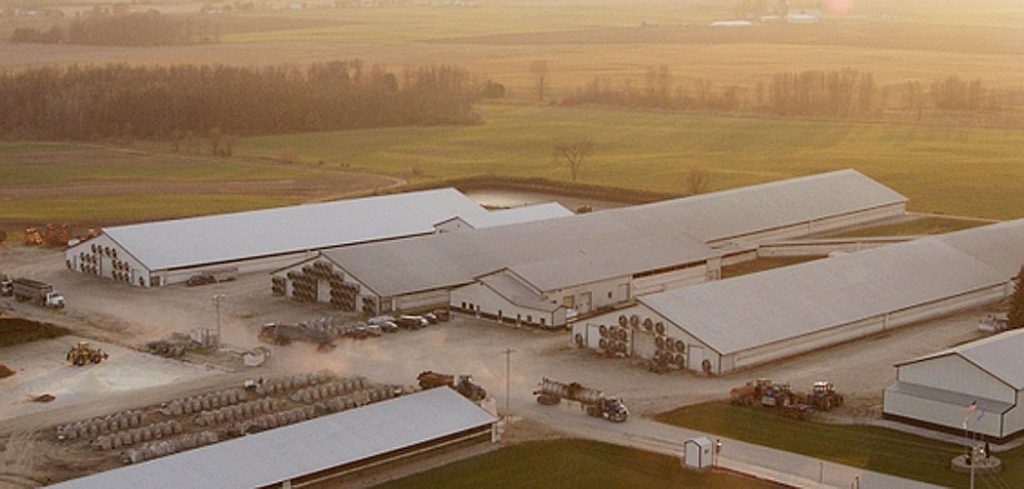
Factory farming is a major concern in Iowa. No one wants to lose their quality of life to a malodorous and potentially hazardous hog confinement. To get an update on this issue and learn how we can help protect our communities, we talked with Diane Rosenberg, Executive Director of Jefferson County Farmers & Neighbors, Inc., and cofounder of the Iowa Alliance for Responsible Agriculture.
What is the current state of factory farms, also called CAFOs (concentrated animal feeding operations), in Iowa today?
Big Pork is big business in Iowa. With 23.6 million hogs in Iowa—50 million produced annually—Iowa continues to dominate the nation’s hog production. Minnesota and Nebraska rank a distant second and third with 8.6 and 8.3 million hogs respectively.
In general, hog production was slightly down across the nation in 2022, likely due to high building costs and COVID-related delays. But 113 CAFO developers still built or expanded new factory farms in Iowa.
Probably the biggest factor that may impact Iowa is the highly anticipated ruling by the U.S. Supreme Court on Proposition 12. If the law is upheld, California retailers will be prohibited from selling pork from CAFOs that use gestation crates, regardless of where they are produced. California consumes 13 percent of the nation’s pork, and since most producers have relied on winning the legal challenge rather than eliminating crates, Prop 12 could have a significant impact here. The industry is nervous.
How did Jefferson County do in 2022?
Fortunately, no new factory farms were built in Jefferson County. However, we are keeping an eye on a couple of areas of possible development.
Our supervisors unanimously adopted the Master Matrix for 2023. The Master Matrix is a tool that provides a somewhat higher degree of community and environmental protection in evaluating a proposed CAFO. But we have not yet gotten any traction on a factory farm moratorium resolution. While there appears to be some support, numerous requests to add this to the county supervisors’ agenda went nowhere.
We are developing Plan B. Stay tuned.
Is there any progress towards regulating CAFOs?
This is a mixed bag. The good news is that co-sponsorship of State Representative Art Staed’s 2022 factory farm moratorium bill increased to 20 state representatives and four state senators—the most to date. We’re building momentum. A new moratorium bill will be introduced again this legislative session.
In 2022, the DNR embarked on its five-year review of all CAFO rules, asking stakeholders for input on their first draft. JFAN worked with the Iowa Environmental Council (IEC) and helped to organize a coalition of community, state, and national groups to review the DNR’s draft and make recommendations.
We submitted a comprehensive list, with 10 other organizations signing on. The DNR incorporated some stakeholder comments and submitted a draft to the governor’s office for preclearance. Once the DNR receives the draft back, a formal public comment period is supposed to commence.
But on January 11, Governor Kim Reynolds issued Executive Order Number 10, putting a moratorium on all rulemaking in order to foster a more pro-business environment. Each agency is charged with reviewing every rule and regulation, determining a cost/benefit analysis for each, and rewriting the entire administrative code with the goal of eliminating as many “unnecessary” rules as possible.
This is a monumental task. We are concerned with losing protective regulations as well as diverting an already understaffed DNR from their job of regulatory enforcement. How the DNR will proceed with this rules review is not yet known.
Tell us about your work with helping other communities and the successes you’ve had.
For nine years I worked as a part-time consultant with the national organization Socially Responsible Agricultural Project (SRAP) helping many Iowa communities opposing CAFOs. Several of these fights were very successful, including in Tama, Howard, Pottawattamie, Wayne, and Washington counties.
Opposing factory farms is hard work, but it’s unpleasant for CAFO developers, too. If a community rises up and remains strong, it frequently deters more development even if the CAFO does get built.
What can people do to protect themselves from CAFOs?
If an unwelcome CAFO comes knocking, it’s critically important to organize and work to oppose it. Communities that don’t often find that it opens the door for further CAFO development. It’s also important to maintain an ongoing vocal presence to let the local CAFO community know there is opposition to factory farms.
It’s also crucial to work on the state level because that’s where definitive changes can be made. Advocate for a factory farm moratorium by contacting state legislators, lobbying in Des Moines or at home, submitting public comments, attending legislative forums, writing letters to the editor—all those efforts build pressure and grow momentum for a moratorium.
Sign up for emails from JFAN and the Iowa Alliance for Responsible Agriculture to receive action alerts and information on lobby days. If you’re not sure how to help, this is a great way to plug in.
Are you hopeful for a change in the future?
Actually, I am. Over the last 16 years, I’ve seen a lot of changes. People are more aware, our moratorium bill is gaining momentum, and 63 percent of Iowans support a moratorium. That’s a very big shift since I began with JFAN in 2007.
Ultimately, CAFOs are not sustainable, and this model will eventually fail. Today’s work lays an important foundation for the change we are building.
To learn more, visit JFANiowa.org and the Iowa Alliance for Responsible Agriculture.
